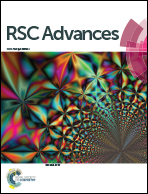Electrode materials based on α-NiCo(OH)2 and rGO for high performance energy storage devices†
Abstract
Described herein is a composite material based on reduced graphene oxide (rGO) and α-NiCo(OH)2 nanoparticles exhibiting very fast charge/discharge processes, like that in capacitors combined with the high energy density of batteries, suitable for application to high performance energy storage devices. NiCo@rGO showed a superior performance compared to stabilized α-Ni(OH)2 and α-NiCo(OH)2 nanoparticles and Ni@rGO, the analogous composite of the former with rGO. In the nanocomposite, each rGO sheet is decorated with stabilized nickel–cobalt hydroxide nanoparticles conferring specific capacitances as high as 1300 F g−1 and discharge rates superior to 100 A g−1. This nanomaterial is also demonstrated to be remarkably stable, retaining up to 96% of its maximum capacitance after 5000 galvanostatic charge/discharge cycles.



 Please wait while we load your content...
Please wait while we load your content...